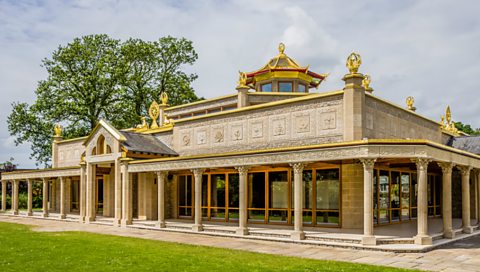Places of worship
In Buddhism there is no single place of worship. This is because Buddhists can worship in the home or in the temple. Although Buddhists show devoutHaving or showing deep religious feeling or commitment. at home, they also use the temple as this is the heart of the community.
Different places of worship
Different Buddhist places of worship serve different purposes:
- Temple – a building that allows many people to come together to learn, meditationThinking quietly as a spiritual or religious exercise. Connection of the mind and soul with the Divine using breathing and other techniques. In Buddhism, using one of a set of techniques or exercises for calming the mind, developing positive emotions and understanding the way things are., celebrate and offer devotion. A temple will contain a shrineA small and special place usually dedicated to the Buddha, where Buddhists may worship alone or as families. and space for community activities.
- viharaA Buddhist monastery, literally 'dwelling place' which is open to the community for study, meditation and worship. – a monastery for monks or nuns who have decided to devote themselves to the Buddhist path. Members of the wider community support the vihara and earn positive karma/kammaActions, and the consequences of actions. An important concept in Buddhism, Hinduism and Sikhism.. The vihara in return supports the members of the community in their spiritual growth.
- Shrine – the site of a statue or image of the BuddhaThe founder of Buddhism, Siddhartha Gautama, after his enlightenment. It is a title which means the enlightened or awakened one., either within a temple or vihara, or alone.
- stupaA burial mound or shrine built to house relics of the Buddha or an important disciple or teacher. – a burial mound built to house relics of the Buddha or another important Buddhist teacher. People often walk around them while chantRepeating religious phrases or quotations from sacred texts. to aid concentration.
- Meditation hall – meditation is one of the most important aspects of Buddhism. It is essential for growing one’s understanding and developing a calm, Buddha-like mind. Whether at a temple or vihara, Buddhists require large spaces dedicated to calm and concentration.

Buddha statues may be found in any of these places of worship. Statues or images of the Buddha are called BuddharupasA statue or image of a Buddha, often Gautama Buddha (the founder of Buddhism).. They show the Buddha in various poses and states. Buddhists do not worship the Buddha as a god, but respect and honour him as a role model and teacher.
Offerings
The different types of offerings Buddhists may give include:
- Food offerings are made to show respect to the Buddha, as if he were an honoured guest.
- Flowers, which will wilt and die, represent impermanenceNot lasting forever..
- Lit candles represent enlightenmentThe realisation of the truth about life. In Buddhism it releases a person from the cycle of rebirth..
- As incensePerfumed cones or sticks that release a nice scent when lit. fills the room with a sweet smell, it represents the spread of the Buddha’s teachings.
- Dana is a donation made to Buddhist monks. Buddhists give it freely with no expectation of reward. Developing dana is one of the Six Perfections – dana paramita (the perfection of generosity).
Buddhist places of worship in the UK and around the world
Both TheravadaMeaning ‘teachings of the elders'. It is primarily focused on the Arhat path to enlightenment. This branch of Buddhism can be found in Sri Lanka and South East Asia. and Mahayana BuddhismOne of the major schools of Buddhism, it includes Tibetan and Zen Buddhism. Buddhism have a presence in the UK. Theravada Buddhism is commonly found in Sri Lanka and South East Asia. Theravada temples and viharas in the UK have been founded by monks and nuns from Thailand, Myanmar (Burma) and Sri Lanka. These temples and viharas in the UK reflect the cultural and linguisticRelating to language. traditions of those other countries. They also reflect universal Buddhist teachings (eg the monks and nuns might wear white clothes).
Mahayana Buddhism is commonly found in the regions north of Buddha’s birthplace in Nepal – Tibet, China, Japan and Korea. Mahayana Buddhists often show devotion to Bodhisattva (also spelt Bodhisatta)In Mahayana Buddhism the bodhisattva is one who has vowed to obtain enlightenment for the benefit of all beings. as well as the Buddha. There are many Mahayana Buddhist places of worship in the UK, serving a range of traditions with origins in countries such as China, Japan, Korea, Tibet and Vietnam.
In Britain it is more common to find Buddhist places of worship using buildings originally intended for other purposes, such as school. However, there are a few which are purpose built and some in traditionally Asian styles.

Question
What is a stupa?
A stupa is a burial mound built to house relics of the Buddha or another important figure.